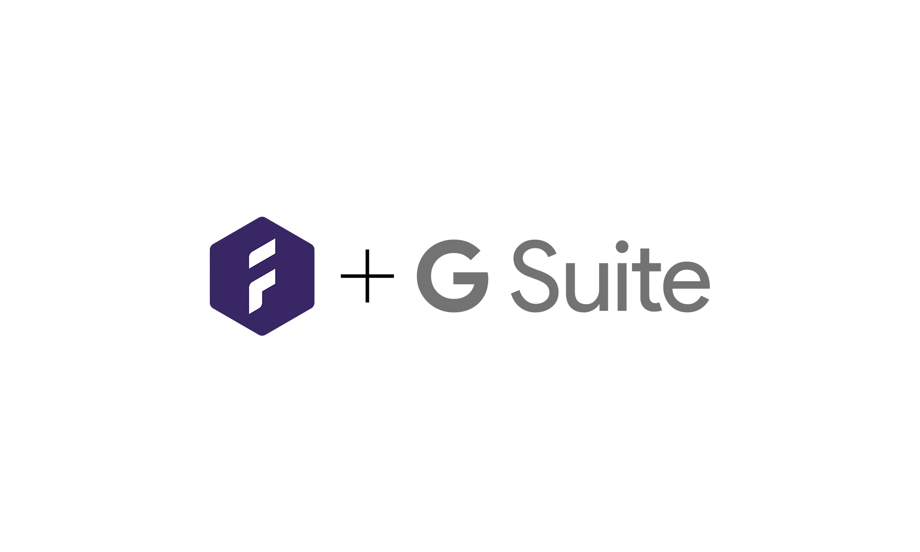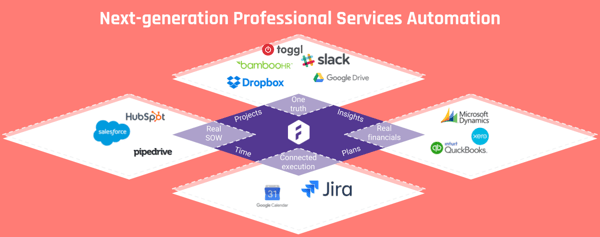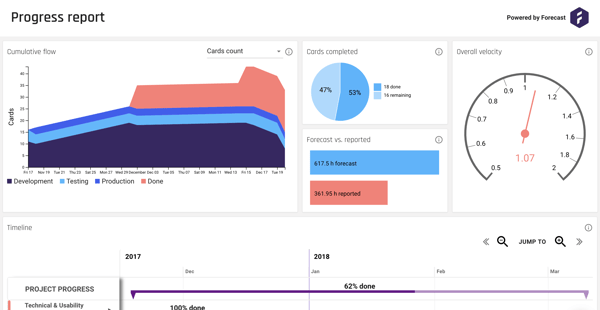High Productivity with Forecast and Google Project Management

Forecast and Google project management
Do you use Google’s G Suite (or, Google Docs) for project management? Or are you just on a look out for a better solution that combines the power of your Google Drive, Google Calendar, Google Docs, etc. with a platform that is 100% optimized for managing internal- and external projects in your business? A platform that improves your workflow, clears the clutter, and takes care of important things like estimates, budgets, scheduling, project timeline, and so forth, while at the same time makes sure to bring you the overview and perspective you need to make the right decisions through real-time automatic insight reports.
In this longform article, we’ll dig into how you can do exactly that; combine the power of the perfect collaborative office suite, G Suite, with a data-driven resource- and project management platform supported by artificial intelligence, Forecast.
First of all, I’ll showcase how G Suite can really improve your daily workflow, and secondly how Forecast can assist where the limits of Google are reached.
As mentioned above, G Suite, more specifically Google Drive, Google Docs and Google Calendar, is a really good office suite. It has the most important foundational features as you probably know from Microsoft Office and other tools, but with the added capabilities of the cloud. It runs completely in the web browser, it’s always in-sync, you can easily collaborate with your team and have several people working on the same document at the same time, and everything is shareable through a link.
Google has really done a great job here, and at the same time you can be pretty sure that your files are saved and backed up in one of the world’s safest data centers. It’s all great, but there are still some downsides when managing larger projects in a more complex business. This is not really Google’s fault, but simply a limit of a traditional office suite. Text documents, spreadsheets, and presentation slides are just not meant to manage complex projects.
It’s still quite common in many organizations to use spreadsheets for stuff like delegating tasks, managing budgets, and doing advanced calculations. All of which is saved in separate files on your drive; in folders, named more or less random things, with different versions and iterations. Even personally it can be a tough job to find the document you’re looking for, but the struggle really becomes a time-consuming (i.e. money) task when other people comes into play as well. Where did George put the file? Is this file the newest version? How do I inform the right people that I updated the file? Does it conflict with another person’s work? The questions, just in terms of file management, are endless.
That’s one reason why we think you need something more. Something more that doesn’t necessarily make your day more complex, but actually quite the contrary; a platform that connects with your existing Google accounts, and just adds on top what is needed to keep everything organized, from managing tasks, taking care of the schedule and budgets, and getting the insights you need to make the right decisions. All of this made as simple, intelligent and effortless as possible. That’s exactly what we aim for with Forecast.
Forecast is a so-called, professional services automation (PSA) platform, which is a new type of platform that connects all of your separate tools, in order to bring you the real-time one-truth into your business and its projects. It’s a resource- and project management platform that digs right into your Google G Suite, among other integrations, and adds features like time tracking, automated budgets based on rate cards and reported billable and non-billable hours, scheduling with ‘quick booking’ to find available people in your team with the right skills for the work you need to get done and book them in a matter of seconds, and always up-to-date customizable and shareable insights. So, you’re always ready for the next meeting with your stakeholders.
Google and Forecast together is really a beautiful symphony or an evil powerhouse, depending on your mentality, with the best of both worlds, connected. Put your files from Google Drive directly on cards (i.e. tasks), assign it to the right people, comment on it, mention people, move it around, and always have the latest file attached directly to the card. Connect your Google Calendar (or any other calendar) to Forecast, and receive your personal tasks directly in your calendar; complete with dates and description. Connect with some of all the other tools you’re already using to sync, import and export data between all of them. Thus, Forecast will turn into your one-stop destination for all of your work.
Next up, I’ll give you some examples on how your company can leverage the best of those tools together.
More structured workflow
When combining the advantages of Google and Forecast; you really get a unique view into your projects. G Suite as your collaborative office suite, and Forecast as your collaborative connected hub of information, management and insights.
You simply activate the integration with Google Drive, and you’re good to go. Now, you’re ready to create cards in the workflow of your projects. Keep all the data regarding this task in one place; description, dates, subtasks, people, time registrations, comments and files attached. With the Google Drive integration, you can link your documents and files from Google Drive directly to the card; so nobody will ever have to look through folders, questioning which one is the newest version. Everybody can directly refer to the card, and even send a link to people internally, or add any stakeholder (e.g. clients, freelancers, etc.) with limited permissions to view their associated project, tasks and follow the progress as well.
Time tracking and productivity
The ultimate key to improving productivity and your team’s utilization is to first know exactly what’s going on right now, and the best way to gain this knowledge is to have your team track and register hours directly on tasks. Now, this is one thing that G Suite needs help with, since it’s simply not possible on the Google platform. Time tracking, not only does this improve your insights into progress, what people are working on, and whether they have too much or too little work to do. It’s also capable of automating your project budgets based on the forecasted estimates, and your team’s billable and non-billable time.
A good general target for utilization is a total of 80%. 60% for external billable projects, 20% for internal non-billable projects, and 20% for other important activities, like drinking coffee.
Your team members can either report time directly from the opened card as seen above, or on the time page by selecting project and card, and enter the amount of hours to register as seen below.
This will instantly be reflected across the system and connected services with support for time reports, if any. Now you can do more proper scheduling and allocation of people, you can use the ‘quick booking’ feature to find available people, and you can follow the progress in insights. Easily share the reports through a password protected link if you need it, e.g. share project timeline, budget, and the progress report with your client.
Additionally, thanks to our AI engine we build a personal algorithm for your organization that improves your predicted estimates on a day-to-day basis. It learns from you and your team’s tracking behavior, as well as other organizations on the Forecast platform. Thus your estimates and predictions should grow more and more accurate, without sharing any information with others. The more you use it, the better it gets.
Tooltip: Connecting and importing data from your existing services, gives you a headstart in feeding your algorithm with valuable information to make your experience better from the beginning.
Scheduling and budgeting
On a more overall organizational perspective, proper scheduling and budgeting is paramount for running a sustainable and profitable business. Two jobs that many try to fit into a spreadsheet environment. It can work, but as your team grows it’s just not a very efficient method to manage people, work and the finances. Nothing is really connected in a spreadsheet, at least not intelligently. If something changes you may have to make major changes to your spreadsheet. Causing confusion for you and others.
With Forecast, we try to make it as easy and fun as possible to allocate people to projects, assign to cards, set up rate cards, and track your time. Scheduling is managed in a proper designed schedule, everything is interactive, so you can drag blocks around, shorten or extend allocations and use the quick booking feature to find the right available people.
This all goes into the budget, which is generated automatically based on the project’s roles, rate cards and registered time. We distinguish between billable and non-billable time, and thus your budget should always reflect the reality. Additional costs can be added manually to make it ready for export and invoicing. Besides being a huge time-saver, it’s also a great way to avoid potential typos and mistyping. Directly export your automated budget into your accounting & billing software in a matter of seconds.
Moreover, as mentioned earlier your schedule and upcoming work is seamlessly synced with your Google Calendar, or another calendar service supporting the iCal format. Connecting everything across services.
Project timeline, AI and Overview
One of the most important things when managing projects is knowing what’s going on, when and how. In other words, overview and perspective. If you’re just using Google Docs it can be a mess. There’s no one place to get the numbers and graphs you need to feel at peace with the progress.
This is where our project timeline, AI and overview come into play. Features that help you get this overview and find peace of mind. The project timeline that always presents your project with milestones and cards within those milestones. You can easily drag around, shorten and extend milestones and cards to change start- and end dates; just like scheduling as we went through earlier.
It’s very common to use a static presentation template for Google Slides or Microsoft PowerPoint to design and present your project timeline, but the problem here is; first of all the work that goes into designing this timeline is a waste of time (if you can avoid it), looking into data spread across heads in the organization is a hassle, different files and folders is a mess, previously written milestones are not always relevant anymore, etc. Secondly, it’s usually not linked with anything. If something changes, or the data you initially built it upon isn’t reliable enough, then you simply can’t use the timeline anymore, and you would have to do the work all over again.
A data-driven interactive project timeline on the other hand is automatically generated based on everything the system knows about your project, and it can be directly shared with your client or any other stakeholder through a link. This means that you no longer have to fiddle around with timelines in Slides and try to make it look good and realistic. You simply do your job, share it when you need it, and continue working on the meaningful stuff.
The AI engine goes into everything in Forecast. It’s the backbone that helps predicting your time estimates that’s the base for intelligent scheduling, budgets, and estimating your project’s timeframe. You can see it across the platform, referred to as “forecast”. An example is when scoping your projects; you enter a low and a high estimate, and Forecast will immediately bring you a more precise estimate based on things like your estimates, the title of the card, labels attached to the card, the roles and people assigned to it, and so forth.
This more accurate time forecast is used to bring you a more accurate budget, because it combines the predicted hours with the rate card linked to each person assigned to the card in the project. Thus, you can have different rate cards for people in different projects. Thereby having a reliable budget automatically generated for each project.
Tooltip: Use the insights section of Forecast to get a portfolio overview, look into the business, the people or each individual project. Bringing you real-time insight reports to act on. Those reports can even be customized to your needs, you can create as many as you’d like, and you can share them with stakeholders simply by sending a unique password protected link.
If you’re a project manager and looking for a more general look on a specific project, the project overview is a great place. It’s the default first page for the managers of a project, and it’s sorta the overall status on the time, scope and budget.
The ultimate goal of these features is to boost your business, improve your profit margins and overall profitability through better utilization of your people. If everybody knows what to do when, who should be involved, and where to find the stuff you need to complete the task at hand; then you’re probably more inclined to a higher productivity and thereby also a better profitability.
More integrations
Does your team, or parts of your team, work with other tools and services as well? Don’t worry! We already connect with some of the most popular apps out there. The app catalog is expanding with new integrations all the time. So, if you can’t find your favorite tool there yet; please reach out to us, and we may have good news for you.

Some of our major integrations that we already integrate with are JIRA, GitLab and Trello. Forecast connects directly with JIRA to sync all your issues, users and projects to Forecast. Deadlines, sprints, milestones, etc. are also synced between both services. GitLab is likewise, issues and status is synced back and forth. Trello imports your boards into Forecast, and is perfect when your startup or team is growing out of Trello.
All of those integrations make it easy to take full advantage of Forecast from the get go. It only takes a few seconds to get started, and you can instantly browse around and see how everything looks on the Forecast platform.
Insight into your business
When you’ve collected all of your data by using and syncing with Forecast, you can begin to build your insight reports as well. Matching our philosophy, we’re striving to make it as simple as possible to get overview and perspective on your projects, people, business and your whole portfolio. We made it automatic and real-time updated, we made it customizable and we made it shareable. You can set up your reports just the way you like, move components around, matching different stakeholders and insight types.

You can create as many as you want, and share them with a unique password protected link. The link will only give access to this specific report and nothing else; thus you’re always in control of what your stakeholder gets to see.
Of course you need some minds looking into the insights, and somebody to build a subjective view on the matter, but we believe that our insights module can greatly improve your productivity, reliability and relevancy of your insights and strategy sessions.
Best of both worlds
For agencies, or any other modern business, you probably have many different services implemented in your daily workflow. All tools that often don’t really speak together very well. Many of them are great tools individually, but when everything is separate, it just lacks the crucial intelligence that is possible when you bring all of your data together in one solution. The system can better assist you in your daily work when it knows what’s actually going on in your business, and help you gain the overview and perspective to make the right decisions for the future of your projects and organization.
So, the conclusion is, keep using G Suite, it’s a great product, but link it up with a PSA platform that can properly communicate with all of your services. This will greatly limit the amount of manual work you have to do, thereby a great time-saver and method to avoid mistyping, and at the same time most likely increase your productivity. Forecast brings the one-truth that can assist you in running overall better, more reliable projects.
If you reached the end of this article, then you probably found it useful, and if so we would like to invite you to a personal meeting with of us from our internal customer success team. Click here, and book a date and time spot that fits your schedule.
Subscribe to the Forecast Newsletter
Get a monthly roundup of productivity tips & hacks delivered straight to your inbox